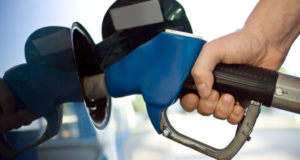|
Listen To The Article
|
 When you head to the gas station to fill up, high gas prices can be disheartening. It turns out that high prices are not the only problem at the pump. Troubling information about E15 gasoline has come to light—it could actually be damaging your car in the long run.
When you head to the gas station to fill up, high gas prices can be disheartening. It turns out that high prices are not the only problem at the pump. Troubling information about E15 gasoline has come to light—it could actually be damaging your car in the long run.
Causing Car Trouble
E15 seems like an environmentally friendly choice: it is a fuel that blends 15 percent ethanol and 85 percent gasoline. E15 was approved for public use in June 2012, and huge media pushes encouraged consumers to purchase E15 in states like Nebraska, Kansas, and Iowa. As more and more gas stations started selling E15, problems with the gas began to come to light (though the EPA has not yet issued a ban on the sale of E15 gasoline).
Phase separation is the most common problem that occurs when using E15 gasoline. When E15 makes it into your vehicle, the ethanol and gasoline separate out and the gasoline rises to the top of your fuel tank. During this process, somewhere between 40-80% of the ethanol sinks to the bottom of the tank and completely separates from the gasoline. This means that the ethanol at the bottom of the tank does not burn as traditionally intended, and it can cost you thousands upon thousands of dollars to repair the damage done to your vehicle.
Problems caused by E15 are so widespread in traditional vehicles that car manufacturers like Chrysler, Nissan, BMW, Toyota, and Volkswagen have released statements that they will not honor warranties if consumers choose E15 at the pump. As many as eight additional car manufacturers have released statements that E15 use will void their warranties, as these companies are unwilling to pay for the early engine damage the fuel causes. Car manufacturers are not the only ones warning consumers about the dangers of E15—companies like AAA have come out with warnings about the harm that E15 can cause your vehicle, discouraging individuals from filling up with E15 unless they drive a flex-fuel vehicles. In December 2012, AAA requested that the EPA stop E15 sales because of the widespread damage to traditional vehicles caused by use of the gasoline. There are 240 million cars and vehicles on the road driven by average American families, but AAA has released a report that estimates that at best, only 12 million of these vehicles can handle E15 gasoline. However, instead of suspending sales as requested, E15 has been introduced for sale in even more locations.
Learn how you can get a free solar generator!
Dozens of studies on the effectiveness and safety of E15 have been conducted, but it is difficult to navigate the (sometimes contradictory) results of these studies. Some studies concluded that E15 could be used safely in any vehicle produced after 1994, such as a study conducted by tech consulting firm Ricardo Inc. Other studies, however, such as the 2012 study conducted by the Coordinating Research Council found that E15 could be damaging to virtually all non-flex vehicles. E15 can cause “premature engine damage,” according to Congressman Jim Sensenbrenner, who is responsible for proposing that the EPA conduct another unbiased study on the engine damage reportedly caused by E15 use. Ultimately, the safest choice is to follow the guidelines issued by your car manufacturer if your car is still under warranty. E15 might be safe to use in some vehicles, especially if they are more recent models, but it is not worth risking your car’s warranty.
E15 is often cheaper than other gasoline choices at the pump; coupled with government efforts to push E15 gasoline on the public, more and more people are choosing E15 gas. However, E15 is a terrible choice for consumers for two reasons: it can completely corrupt your fuel tank, and it is not even the most cost effective choice. The miles per gallon that you get out of E15 is usually lower than the gas mileage that you would get out of other options at the pump.
Government Subsidies
If E15 gas is such a harmful substance, the fact that the government is encouraging its usage does not seem to make much sense. The truth behind the matter is that huge corn subsidies are responsible for the production of E15, and the government has a huge financial incentive to encourage consumers to choose E15 at the pump.
The billions of dollars in corn subsidies that the government provides every year has started a troubling trend: farmers have stopped producing food crops and begun producing corn, which is then used to produce ethanol. This change in farming practices serves a stark explanation for the marked rise in food prices across the country; as fewer farmers devote land and resources to producing food crops, the few farmers who maintain traditional crop divides can afford to push prices up, a practice that is only magnified when retailers market food products.
Alternatives to E15 Gasoline
While E15 can cause car-damaging problems in most vehicles, certain vehicles are still safe to run E15 gas. The reason that E15 is problematic because there is a higher concentration of ethanol than is present in most of the gas you choose now, and traditional fuel tanks cannot handle such high ethanol concentrations. If your car was manufactured after 2007, it is likely that you are okay to continue to choose E15 at the pump. This is because car manufacturers have adapted fuel tank components to deal with higher concentrations of ethanol. For that reason, flex-fuel vehicles can also run E15 without a problem. In fact, most flex-fuel vehicles can handle ethanol blends that contain up to 85 percent ethanol and 15 percent gasoline because they have fuel tanks specifically manufactured to handle large concentrations of ethanol.
If you are driving a traditional (non flex-fuel) vehicle, it is probably a better bet to stick to traditional gasoline (which can contain up to 10 percent ethanol) until you can transition to a fuel-efficient vehicle that can run on forms of gasoline with higher concentrations of ethanol. Stick to filling up at gas stations that do not offer E15, or at least offer it at a completely separate pump. If you pump gas from a single nozzle that dispenses both E10 and E15, leftover amounts of E15 from previous customers can still end up in your tank. This is especially important if you drive a smaller vehicle or are only adding a small amount of fuel to your tank, as the E15 will have less chance to be diluted with the E10.
For flex-fuel vehicle drivers, the choice between E15 and E85 is much less costly, and your car should be able to run either comfortably. Like E15, E85 tends to get a lower mileage rating than traditional gasoline. E85 is also guilty of exploiting corn subsidies and driving up food prices. On the other hand, E85 is a renewable fuel that can keep your dollars headed to U.S. businesses, rather than overseas exporters of oil and gasoline. In the end, only you can decide which one you believe is the lesser of evils.
©2013 Off the Grid News
 Off The Grid News Better Ideas For Off The Grid Living
Off The Grid News Better Ideas For Off The Grid Living




